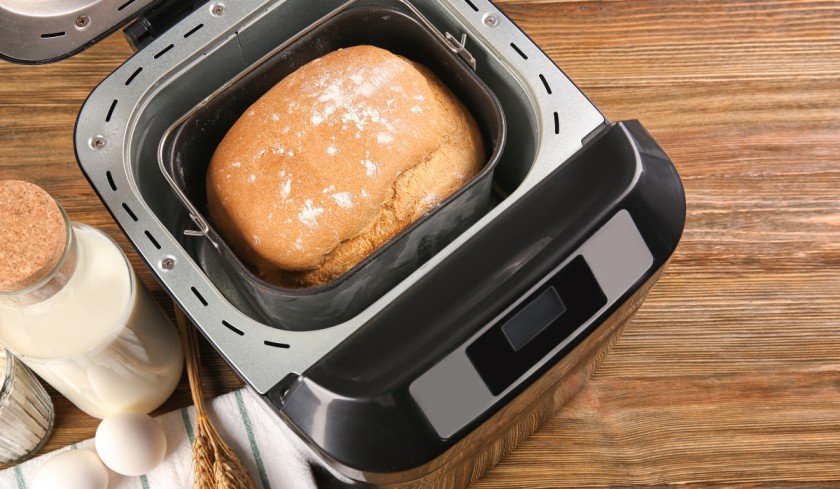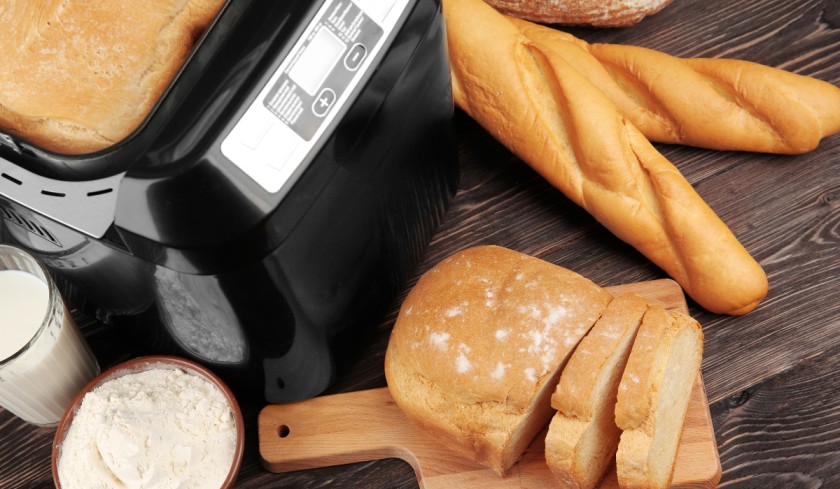Mixing
The machine uses a motor-driven paddle to mix ingredients.
Ingredients are combined uniformly without manual effort.
Kneading
The paddle mimics the kneading action necessary to develop gluten.
Gluten traps air bubbles and gives bread its structure.
Proofing (Rising)
The dough is left to rise inside the warm, controlled environment of the machine.
This step activates the yeast, causing fermentation and expansion.
Baking
The built-in heating element ensures even baking of the bread.
Some machines allow you to bake only (e.g., for pre-made dough).
Basic Models
Ideal for simple bread recipes like white or whole wheat bread.
Limited customization options.
Advanced Models
Offer features like gluten-free settings, jam-making, or programmable cycles.
May include dual paddles for better kneading.
Mini Bread Makers
Compact and suitable for smaller households.
Produces smaller loaves (1-1.5 pounds).
Pre-Programmed Settings: Basic, whole wheat, gluten-free, French, sweet, and more.
Delayed Start Timer: Set the machine to start hours later, so fresh bread is ready when you want it.
Crust Control: Adjust crust color (light, medium, dark).
Keep Warm Function: Keeps bread warm after baking, typically for 1 hour.
Dough Mode: Prepares dough for shaping and baking in a traditional oven.
Popular Model: Kent Atta & Bread Maker
Features:
Multi-functional: Can make bread, knead dough for chapatis, and prepare pizza dough.
Pre-set menus for different bread types.
Automatic mixing, kneading, and fermentation.
Price Range: ₹7,000 – ₹10,000
Why Choose: Reliable and suitable for Indian kitchens with its dough kneading option.
Popular Model: Panasonic SD-P104
Features:
13 automatic programs for various bread types.
Gluten-free and French bread options.
Delayed timer and crust color settings.
Price Range: ₹20,000 – ₹25,000
Why Choose: High-quality build and consistent performance, but on the pricier side.
Popular Model: Hamilton Beach Home Baker 29882-IN
Features:
12 pre-programmed settings for a variety of breads and doughs.
Two loaf sizes and three crust options.
Compact and beginner-friendly.
Price Range: ₹12,000 – ₹15,000
Why Choose: User-friendly and versatile, perfect for households.
Popular Model: Bajaj Platini BM01
Features:
Affordable and compact.
Suitable for basic bread-making needs.
Limited features compared to high-end models.
Price Range: ₹6,000 – ₹8,000
Why Choose: Budget-friendly for entry-level users.
Popular Model: Glen SA 3034 Bread Maker
Features:
12 pre-set programs for bread, cakes, and dough.
Detachable non-stick baking pan.
Compact design for smaller kitchens.
Price Range: ₹8,000 – ₹10,000
Why Choose: Affordable and practical for everyday use.
Popular Model: Morphy Richards 48280 Bread Maker
Features:
Programmable settings for bread and cakes.
Three crust options and multiple loaf sizes.
Easy-to-use control panel.
Price Range: ₹10,000 – ₹15,000
Why Choose: Trusted international brand with good after-sales support in India.
Popular Model: Inalsa Bread Chef
Features:
Pre-programmed options for different bread types.
Lightweight and compact.
Affordable pricing.
Price Range: ₹6,000 – ₹8,000
Why Choose: Great for first-time users and budget-conscious buyers.
Capacity: Choose based on your household size (e.g., 500g, 750g, or 1kg loaf).
Features: Look for customizable options like loaf size, crust control, and gluten-free settings.
Power Usage: Ensure it aligns with your energy consumption preferences.
Ease of Cleaning: Non-stick baking pans are easier to maintain.
Budget: Decide based on how frequently you’ll use it.
Convenience:
Automates the entire process (mixing, kneading, rising, and baking).
Requires minimal effort—just add ingredients and press start.
Fresh and Healthier Bread:
Control over ingredients (no preservatives or additives).
Customizable recipes for dietary needs (e.g., gluten-free, sugar-free).
Cost-Effective:
Saves money compared to regularly buying artisanal bread.
Reduces waste with precise loaf sizes.
Versatility:
Many models allow you to make dough (pizza, pasta, buns) or even non-bread items like jam or cake.
Customizable Settings:
Choose loaf size, crust color, and bread type.
Experiment with mix-ins like nuts, seeds, or dried fruit.
Time-Saving:
Delayed start timer lets you wake up to fresh bread.
Eliminates the need for manual kneading and monitoring.
Consistent Results:
Produces uniform loaves with even textures and crusts.
Limited Crust Quality:
Some users find that bread makers don’t produce a crispy crust like traditional ovens.
Solutions like baking the dough in an oven may be necessary.
Small Loaf Sizes:
Most machines make small-to-medium loaves (500g–1kg), which may not suffice for larger families.
Texture Differences:
Bread from machines can have a different texture compared to handmade or store-bought bread (e.g., denser crumb).
Learning Curve:
Requires experimentation to perfect recipes.
Ingredient order and measurement precision are crucial.
Space Consumption:
Bread makers can be bulky and require countertop space.
Not ideal for small kitchens.
Cost of the Machine:
Initial investment can be significant (₹6,000–₹25,000 depending on the model).
Specialized Ingredients:
Recipes often call for bread flour or specialty ingredients not always available locally.
Noise:
Kneading can be noisy, especially in budget models.
Manual Cleaning:
Some machines require hand-cleaning of non-stick pans and paddles.



